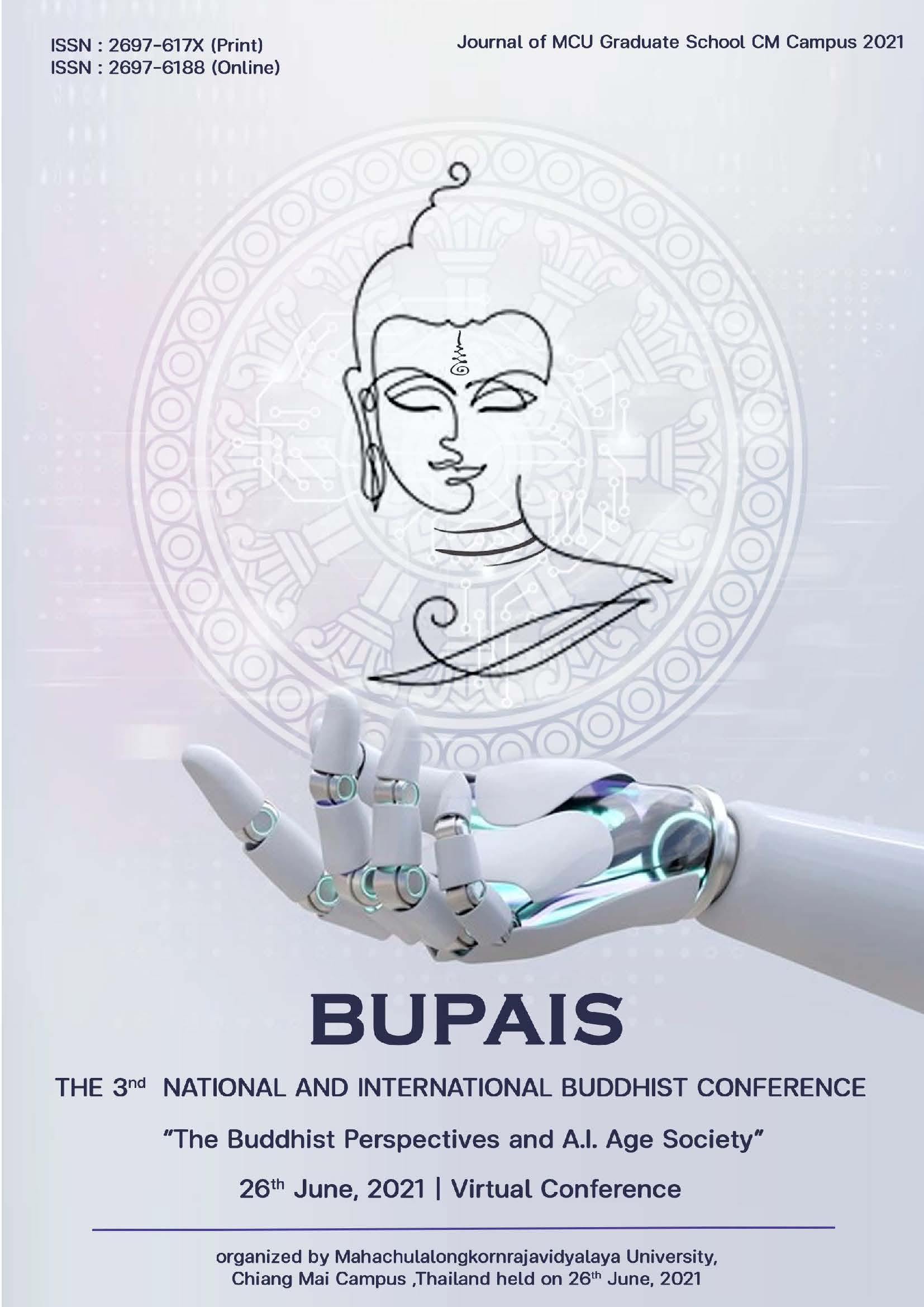ศึกษาการบริหารความเสี่ยงตามแนวพระพุทธศาสนา
บทคัดย่อ
การวิจัยนี้มีวัตถุประสงค์ 3 ประการ คือ 1) เพื่อศึกษาความเสี่ยงที่มีต่อพระพุทธศาสนา 2) เพื่อศึกษาการบริหารความเสี่ยงตามแนวพระพุทธศาสนา และ 3) เพื่อเสนอแนวทางการบริหารความเสี่ยงของพระพุทธศาสนาในสังคมปัจจุบัน เป็นการวิจัยเชิงเอกสาร โดยค้นคว้าจากคัมภีร์พระไตรปิฎก อรรถกถา ฎีกา แล้วนำมาเรียบเรียงเพื่อนำเสนอข้อมูล ผลการวิจัยพบว่า
1) ความเสี่ยงที่มีต่อพระพุทธศาสนา มีอยู่ 2 ประการ คือ 1) ความเสี่ยงภายใน หมายถึง ความเสี่ยงหรือภัยที่เกิดจากพุทธบริษัท 4 โดยการประพฤติเสื่อม หรือทำให้วิปริต 2) ความเสี่ยงภายนอก หมายถึง ความเสี่ยงหรือภัยที่เกิดจากบุคคลภายนอกศาสนา การรุกรานจากศาสนาอื่น และปัจจัยทางสังคม ความเสี่ยงทั้ง 2 ประเภทนี้ถือเป็นภัยคุกคามในการดำรงอยู่ของพระสัทธรรมและความดีงามแห่งสงฆ์
2) การบริหารความเสี่ยงตามแนวพระพุทธศาสนา เป็นหลักการและวิธีการที่พระพุทธเจ้าทรงบัญญัติเพื่อการบริหารจัดการพระพุทธศาสนาครอบคลุมทั้งการปกครอง และการเผยแผ่พระพุทธศาสนา โดยในด้านการปกครองนั้นจะเห็นได้ชัดเจนว่ามีส่วนสำคัญในการทำให้พระพุทธศาสนาตั้งมั่น พระสัทธรรมดำรงอยู่มี 2 ประเด็น คือ (1) การบริหารความเสี่ยงด้านการบัญญัติพระธรรมวินัย ที่บัญญัติขึ้นเมื่อมีเหตุประพฤติเสื่อม เพื่อควบคุมการละเมิดพระวินัยให้เกิดความผาสุกแห่งคณะสงฆ์ (2) การบริหารความเสี่ยงด้านหลักธรรมคำสอน ทรงบัญญัติหลักมหาปเทส 4 เพื่อเป็นเกณฑ์ในการติดสินพระธรรมวินัยเมื่อเกิดปัญหาสัทธรรมปฏิรูป และการพัฒนาพุทธบริษัทที่จะออกไปเผยแผ่หลักธรรมคำสอนด้วยการฝึกอบรมตนให้เกิดปัญญาที่แท้จริง เพื่อยังความเลื่อมใสของประชาชนให้เกิดขึ้น
3) แนวทางการบริหารความเสี่ยงในสังคมปัจจุบัน มี 3 ประเด็น คือ (1) การบริหารความเสี่ยงตามหลักพระธรรมวินัยของคณะสงฆ์ มีแนวทางการประยุกต์ใช้ที่สำคัญ คือ การยึดพระธรรมวินัยเป็นหลักการสูงสุดและมอบอำนาจให้คณะสงฆ์เป็นใหญ่ โดยเป็นผู้จัดการทั้งในด้านการส่งเสริมการเรียนรู้ การพัฒนาบุคคล และการแก้ไขปัญหาที่เกิดขึ้นกับคณะสงฆ์ โดยมีการบูรณาการหรือประยุกต์ใช้ร่วมกับศาสตร์สมัยใหม่ ภูมิปัญญาสากล และภูมิปัญญาท้องถิ่น เพื่อนำไปสู่เป้าหมาย คือ การรักษาสืบทอดพระธรรมวินัย การเผยแผ่พระพุทธศาสนา รวมทั้งการพัฒนาบุคคลและสังคม (2) การบริหารความเสี่ยงด้านการบริหารกิจการคณะสงฆ์ เป็นการพัฒนาการทำงานคณะสงฆ์ที่จะทำได้โดยตรงคือ การให้คำแนะนำทางจิตใจ เป็นที่ปรึกษาเกี่ยวกับปัญหาชีวิตต่าง ๆ สามารถเป็นที่พึ่งทางจิตใจด้วยการประพฤติตนเป็นแบบอย่าง ด้วยภารกิจ 6 ด้าน ได้แก่ ด้านการปกครอง ด้านการศาสนศึกษา ด้านการศึกษาสงเคราะห์ ด้านการเผยแผ่ ด้านการสาธารณูปการ และด้านการสาธารณะสงเคราะห์ เป็นการดำเนินงานพื้นฐานที่อาศัยการมีส่วนร่วมกับชุมชน คือ วัดพึ่งชุมชน ชุมชนพึ่งวัด เพื่อให้เกิดความเจริญยิ่งขึ้นตามหลักการทางพระพุทธศาสนา และ (3) แนวทางการบริหารความเสี่ยงด้านพื้นที่เครือข่ายองค์กรพระพุทธศาสนา โดยมีการปรับประยุกต์หลักพุทธธรรมเข้ากับบริบทของพื้นที่ชุมชน และวัฒนธรรมท้องถิ่น มีการวางแผนร่วมกับชุมชน ภาครัฐ เอกชน เพื่อพัฒนาให้เหมาะสมกับพื้นที่และตามหลักพระพุทธศาสนา โดยใช้กลไก คือ การประสานงาน การติดต่อสื่อสาร การติดตามประเมินผล และการทำกิจกรรมร่วมกัน รวมถึงการสามารถประยุกต์ใช้หลักพุทธธรรมในการทำงานอีกด้วย เช่น หลักอปริหานิยธรรม 7 เพื่อสร้างความมั่งคงมิให้เกิดความเสื่อมขององค์กร หรือการใช้ลักอริยสัจ 4 เพื่อนำไปสู่การบรรลุเป้าหมายในการทำงานที่แท้จริง
บรรณานุกรม
พระครูโฆษิตสังฆพิทักษ์. (2561). การบริหารจัดการความเสี่ยงทางพระพุทธศาสนาและวัฒนธรรมขององค์กรพระพุทธศาสนาในจังหวัดแพร่. ดุษฎีนิพนธ์พุทธศาสตร์ดุษฎีบัณฑิต. สาขาวิชาพระพุทธศาสนา. บัณฑิตวิทยาลัย: มหาวิทยาลัยมหาจุฬาลงกรณราชวิทยาลัย.
พระเทพวิสุทธิกวี (พิจิตร ฐิตวณฺโณ). (2542). ทําไมพระพุทธศาสนาจึงเสื่อมจากอินเดีย. กรุงเทพมหานคร: โรงพิมพ์มหามกุฏราชวิทยาลัย.
พระมหาสุทิตย์ อาภากโร (อบอุ่น) และคณะ. (2556). การพัฒนาระบบการบริหารจัดการและการสร้างเครือข่ายองค์กรพระพุทธศาสนาในประเทศไทย. สำนักสนับสนุนสุขภาวะองค์กร สำนักงานกองทุนสนับสนุนการสร้างเสริมสุขภาพ (สสส.).
พระมหาเสรีชน นริสฺสโร (พันธ์ประโคน) และคณะ. (2561). การป้องกันและแก้ไขปัญหาการละเมิดพระธรรมวินัยของพระสงฆ์ที่ส่งลต่อวิกฤติศรัทธาของชาวพุทธตามหลักนิติปรัชญา. รายงานการวิจัย, (สถาบันวิจัยพุทธศาสตร์: มหาวิทยาลัยมหาจุฬาลงกรณราชวิทยาลัย.
มหาจุฬาลงกรณราชวิทยาลัย. (2539). พระไตรปิฎกภาษาไทย ฉบับมหาจุฬาลงกรณราชวิทยาลัย. กรุงเทพมหานคร: โรงพิมพ์มหาจุฬาลงกรณราชวิทยาลัย.

